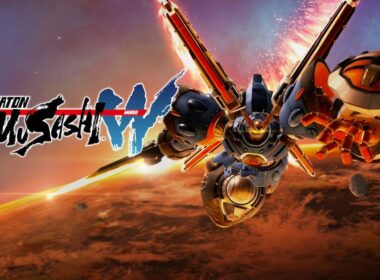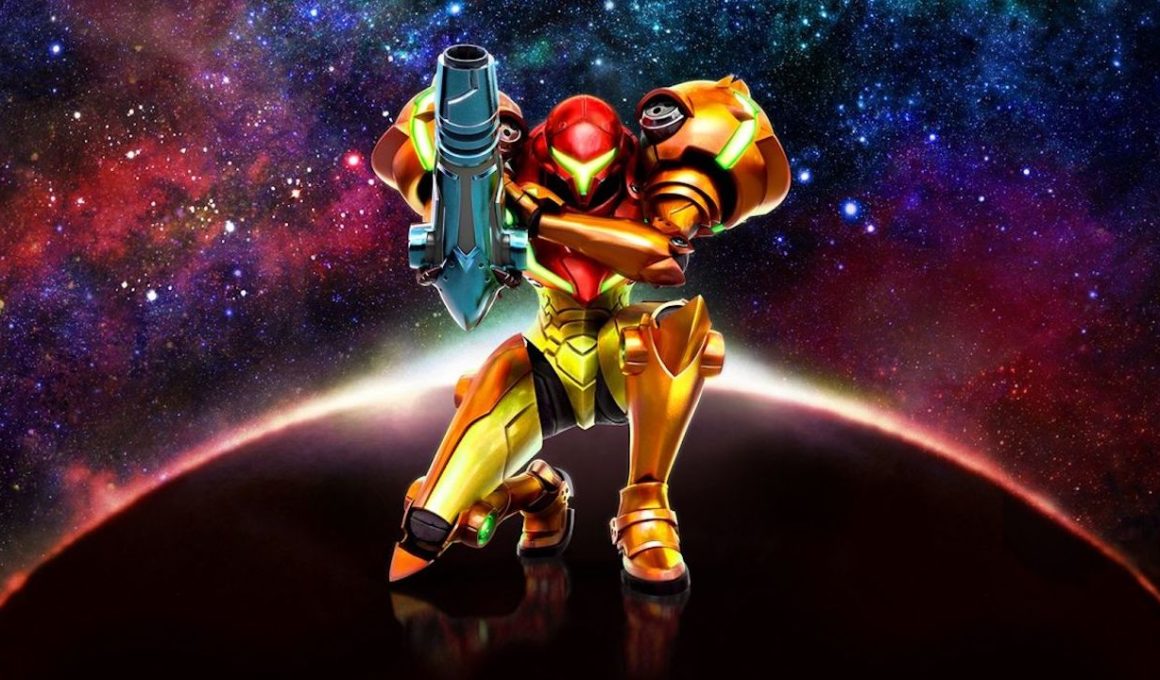Samus Returns. As a big fan of the Metroid series, it is really great saying that.
Fans all over the world rejoiced when Nintendo gave us a trailer consisting only of a logo when announcing Metroid Prime 4 at E3 this year. Then, to shock us even more, during the Treehouse live segment they went and announced Metroid: Samus Returns on the 3DS, a remake of Metroid 2: Return of Samus on the Game Boy. The remake of this particular game was a massive delight for me because I have completed every single Metroid game except for one, Metroid 2. Oh and Federation Force, but that isn’t Metroid.
I have played Metroid 2, albeit fairly fleetingly in the 25+ years it has been out. I think the reason for that is because I grew up with Super Metroid as my starting point, I guess I just expected a certain quality that I just couldn’t find in the Game Boy game. That isn’t Metroid 2’s fault, it is simply that Super Metroid was just that good. It is unfortunate because this remake makes me regret that decision a bit now and makes me feel guilty because this is a wonderful Metroid game and I am sure the original was too.
First things first, the story in this game is exactly the same the original source material and even though that was over a quarter of a century ago at this point, I am not going to start ruining any major plot points for people that have no idea what happens as the game progresses. The game begins with an introduction sequence in the same kind of style shown in Super Metroid, summarising the events of the original Metroid. A Galactic Federation research team discovered an unknown life-form on planet SR388 but was attacked on their voyage home by Space Pirates who wanted to use these life-forms, known as Metroids, for their own deeds. They then send Samus in to infiltrate planet Zebes where the Space Pirates were. She seemingly eradicates the Metroids and kills Mother Brain on Zebes, however, Metroids are discovered to still be on planet SR388 and the bounty hunter is once again sent in to defeat them once and for all. This is your mission throughout the game, kill the Metroids one by one and slowly reduce their population on the planet. The Metroids in this game act as a mini boss of sorts.
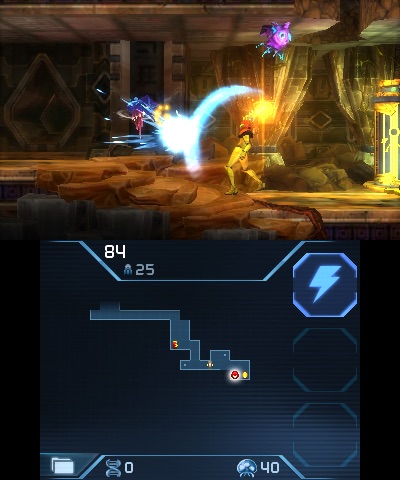
The gameplay found here is very reminiscent of other 2D Metroid games and that is exactly what I and the fans want. If you have never played a 2D Metroid game before, you typically explore cave like environments, kill unfriendly aliens, and collect power-ups that in turn will then gain you access to new areas. It is a structure that worked over 30 years ago with the original game and will continue to do so for the next 30 years.
Most of the fundamental capabilities Samus usually learns makes a return here too, such as Missiles, Grapple Beam and Ice Beam. Probably the most iconic one, the Morph Ball, allows Samus to roll up into a ball in order to enter small tunnels and openings, which previously would not have been accessible. Whilst in this form you can use a variety of other abilities too such as a Morph Ball bomb, which can kill enemies, break certain objects and allow Samus to jump if the bomb explodes underneath her. Another upgrade, the Spider Ball, is one of the most important upgrades in terms of opening up exploration. It allows Samus to adhere to walls and ceilings when in Morph Ball form, thus allowing her to reach quite a lot of places in the game, with the exception of certain areas on walls that are covered in some sort of substance that the Spider Ball just cannot grip onto.
What has always made Metroid so interesting is the amount of secrets you can uncover in each area. So what you might think is a dead end might, in fact, be a destroyable wall and thus will lead to either a power-up such as a Missile expansion or it could lead to a brand new area. You always have to be on the ball and keep thinking about which walls or places look like they might be hiding something behind and then start using whatever power-ups you have and see if any work.
What makes this version of the game unique to any other Metroid title is the introduction of a few major new additions. First of all, we have Free Aim which allows Samus to aim in full 360 degrees whilst being fixed to the floor, rather than just being able to aim horizontally, vertically and diagonally as was only previously available in the 2D titles. A laser sight has been added to Samus’ Arm Cannon to help the player know exactly where they are aiming and it will glow red when it meets an enemy. The Free Aim system works amazingly well and at times when I was then thinking back to previous titles it actually made them seem quite limited because any enemy you see that is in sight can now be hit, which seems so basic a function when you say it like that, but before now that wasn’t always the case.
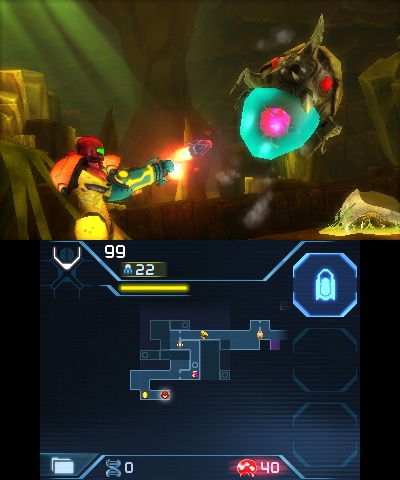
Another major addition is the Melee Counter which takes some getting used to and you will get hit a lot at the beginning portion of the game but when you get to grips with it, it feels very fluid and you will be taking down enemies like the true bounty hunter that you are. You will know when an enemy is about it hit you because a white flash appears and all you have to do is press the Y button to block the attack to stun the enemy, you then automatically aim at it and you can easily dispose of the enemy with a swift shot or two. Grab sequences also make an appearance here and you activate them the exact same way you would activate a normal counter, but Samus can only grab the larger enemies like the Metroids.
Aeion Abilities is the last big addition to Metroid: Samus Returns and there are four of them in total. Each of them uses up Aeion energy that is stored in your Aeion Gauge (which can be upgraded). The first one you receive is Scan Pulse which makes the surrounding area on the map be revealed, temporarily allowing you to see locations of breakable blocks and areas you haven’t yet visited. I never actually used this ability after the first hour of playing as I thought it was a bit of a cheating ability. When I play Metroid games I love to explore myself to find all the secrets but the Scan Pulse would have completely ruined that for me by basically showing where everything is.
Next up we have Lightning Armor that surrounds Samus with an electrical shield which prevents any physical damage to be done to her and powers up your own Melee Counter. Again, I avoided using this one too. Next is Beam Burst which strengthens beam shots and holding Y allows you to fire a continuous stream of shots so you can take down enemies quicker and easier. Lastly, we have Phase Drift which slows everything down except for Samus. This allows you to attack fast moving enemies and traverse over terrain that might collapse by itself if you hadn’t slowed down time.
I must admit, I am not a massive fan of the graphical style used here. They have gone for a look that just looks a little too basic and it definitely isn’t the prettiest game on 3DS. It isn’t a massive turn off and it certainly isn’t bad by any means. With it being Nintendo they do still manage to add in small little details such as seeing little insects poking through gaps in walls, which doesn’t really add anything but makes the world feel a bit more alive. The 3D works pretty well for the most part but I chose to turn it off for 90 percent of my playthrough. It is pretty cool seeing how much depth the areas have that you’re exploring but the novelty wears off pretty quickly and like me, I will guess that most players will choose to turn it off.
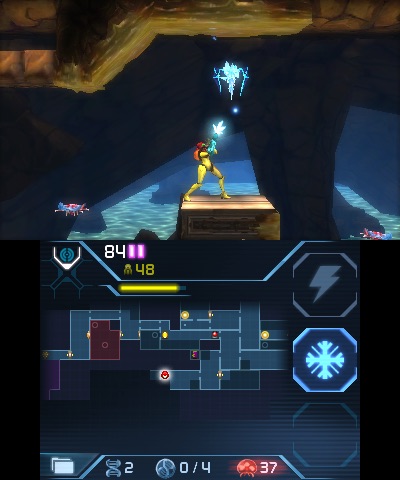
I have to say that Metroid has always had a great score, with some truly iconic pieces standing out. Here is no different. Each track helps create the kind of atmosphere that Metroid is known for, which for a 2D side-scrolling game is not an easy accomplishment. There are some unbelievably good tracks in here that are mostly remixes of older pieces you will find in other titles (which I am perfectly fine with), mainly the earlier games with some more recent tunes thrown in there for good luck too, including my favourite from Prime 1, Magmoor Caverns. The composer, Kenji Yamamoto, has done it again, I am absolutely in love with the soundtrack. Easily one of the best on the 3DS.
Just a side note; I was not able to test out any amiibo functionality, unfortunately, so I am unable to comment fully on whether or not the amiibo are worth getting just for this game. Based on what I know, nothing major is added, you can get an Aeion, Energy and Missile Reserve Tanks, Concept Art and artwork by scanning them in. The Metroid amiibo seems to have the best uses if you had to go for any as you are able to unlock Fusion Mode after you complete the game and reveal the location of the nearest Metroid.
Metroid: Samus Returns is a great remake of a game that quite frankly, needed an upgrade. MercurySteam has done a grand job at bringing a game that was made for a black and white 8-bit handheld, and completely recreate it from the ground up for a brand new generation to enjoy. If you are a fan of the 2D Metroid series then you know exactly what you’re getting. If you are new then it is a fantastic entry point to the series and it is more than worth a playthrough. It certainly isn’t the best Metroid game in my opinion, but it’s a fine one nonetheless. Samus has returned and it puts the series well and truly back on the map.
Version Tested: Nintendo 3DS
Review copy provided by Nintendo




